13 Health Benefits of Malasana & How to Do It?
If you are suffering from digestion problems and having trouble passing your bowel regularly, you can take the help of yoga asanas. One such asana is Malasana, which aims to improve your digestive health and ease your bowel movements. Read along to learn more about the benefits of Malasana, how to perform it, and its precautionary measures.

Table of Contents

What is Malasana?
Malasana, or Garland Pose, is a squatting posture that benefits the digestive system, lower back, and hips. The name comes from the Sanskrit words 'mala,' meaning garland, and 'asana,' meaning yoga pose.
How to Perform Malasana (Garland Pose)?
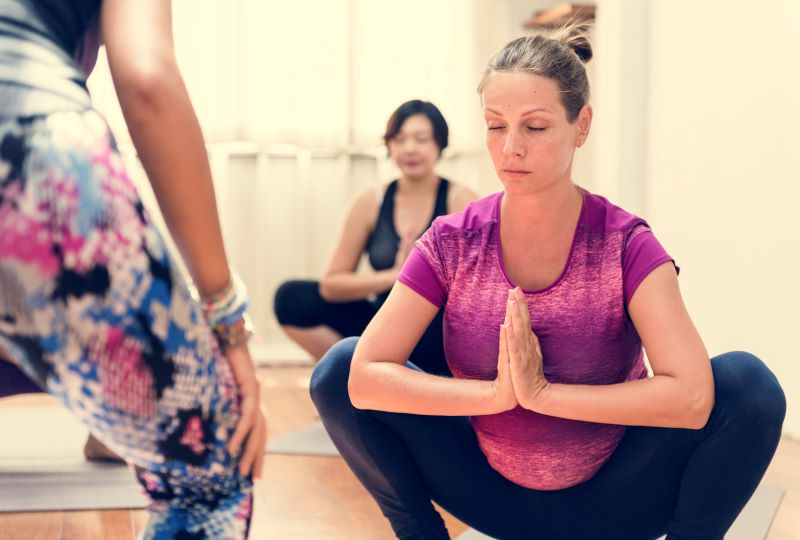
Now that you know the benefits of Malasana, you might be wondering how to start with it. So, here is a step-by-step guide for your better understanding.
Step 1: Start squatting with your feet, keeping them as close together as possible. It would be better if you keep your heels on the floor; otherwise, you can keep them on a folded mat.
Step 2: Now, separate your thighs, keeping them slightly wider than your torso. Now keep exhaling and fit your torso snugly between your thighs while leaning forward.
Step 3: In the next step, you need to press your elbows against your knees and bring your palms together in a salutation seal. Pressing your knees into the elbows will help lengthen your front torso.
Step 4: The next step requires you to press your inner thighs against the sides of your torso. Keep your arms forward and throw them out to the sides. Next, notch your shins into your armpits while pressing your fingertips to the floor. You can also try reaching around the outside of your ankles and getting a hold of your back heels.
Step 5: Hold this position for 30 seconds to 1 minute. Remember to inhale, straighten your knees, and then stand.
13 Health Benefits of Malasana
The Malasana has several benefits for your health. Listed below are a few:
1. Helps in Toning the Lower Body
Due to the inactive and sedentary lifestyles, most of us lead, our legs gradually lose their strength and suppleness. This inactive lifestyle is also responsible for weakening the lower back muscles and abdomen. Malasana is one such effective yoga pose that helps tone the entire lower body. This pose works on the legs' calf muscles, quadriceps, and gluteal muscles and lowers the hamstrings. In addition, it also strengthens the core and lower back muscles.
2. Acts as a Powerful Hip Opener
The long 8—to 9-hour shifts in the office require most of us to sit down in one place for a long time. This damages the hips and declines the health of the spine, body, and back. Regular practice of Malasana results in increased legs, hips, and back mobility. In between your work, take breaks from the chair and practice this pose for a few minutes. In addition, it helps in better blood circulation and keeps your reproductive organs healthy.
3. Helps Maintain Posture
A hunched-down posture leaves a bad impression on people. However, it is a result of poor body awareness. Therefore, practising Malasana will constantly remind you to lift higher, maintain a neutral spine position keep a straight spine, and ensure your shoulders are pulled back.
4. Increases Range of Motion in Knee and Ankle
The knee and ankle are the two joints that help you improve balance, secure stability, and successfully perform day-to-day activities. Moreover, one of the greatest benefits of Malasana for your body is bone strengthening in the knee and ankle joints. Therefore, it is effective in preventing osteoporosis in later life. Moreover, with regular practice of this asana, you can notice an enhancement in the mobility of joints.
5. Relieves Menstrual Pain
When you find yourself in pain and in an uncomfortable position during your menstruation, you can try practising the Malasana pose. It is beneficial in opening up the hips and the downward energy releases some discomfort and intensity.
6. Promotes Better Digestion
Regular Malasana practice can greatly enhance digestive health. By massaging the abdominal organs, the squatting position improves digestion and relieves constipation and bloating. This yoga pose stimulates the digestive fire and ensures smoother bowel movements.
7. Reduces Lower Back Pain
Lower back pain can be effectively relieved by doing Malasana. This pose helps relieve tension and chronic pain by strengthening and stretching the lower back muscles. It also enhances flexibility, making the lower back more resilient to strain.
8. Improves Pelvic Floor Health
For both men and women, maintaining a healthy pelvic floor is essential. By strengthening the pelvic floor muscles, Malasana helps to improve pelvic health overall and prevent and treat conditions like incontinence. It is especially advantageous for recuperating from childbirth.
9. Calms the Mind
This is a beneficial pose for the mind and body. The deep squat fosters mindfulness and concentration, which can lessen stress and anxiety. Including Malasana in your practice can help you feel more in control and at ease.
10. Boosts Circulation
Malasana promotes better blood circulation all over the body. Better blood flow to the lower extremities is made possible by the squatting position, which is especially advantageous for those who have circulatory problems. Improved circulation makes sure that all body parts effectively receive oxygen and nutrients.
11. Increases Flexibility
Frequent Malasana practice improves ankle, knee and hip suppleness. This increased flexibility can facilitate the execution of other yoga poses more easily and improve general movement in day-to-day activities.
12. Supports Detoxification
The squatting posture of Malasana aids in detoxifying the body. By stimulating the digestive organs and improving circulation, this pose helps in the removal of toxins from the body. A cleaner system can lead to improved health and vitality.
13. Enhances Balance and Coordination
Malasana helps in improving balance and coordination. By holding the squatting position, the body learns to maintain stability and control, which can be beneficial for overall physical coordination and preventing falls, especially in older adults.
The Mudras of Malasana (Garland Pose)
Mudras, or hand gestures, can enhance the practice of Malasana, amplifying its physical and mental benefits. These subtle yet powerful gestures help in directing the flow of energy within the body, fostering a deeper state of concentration and mindfulness. Here are some mudras that can be integrated into Malasana:
1. Anjali Mudra
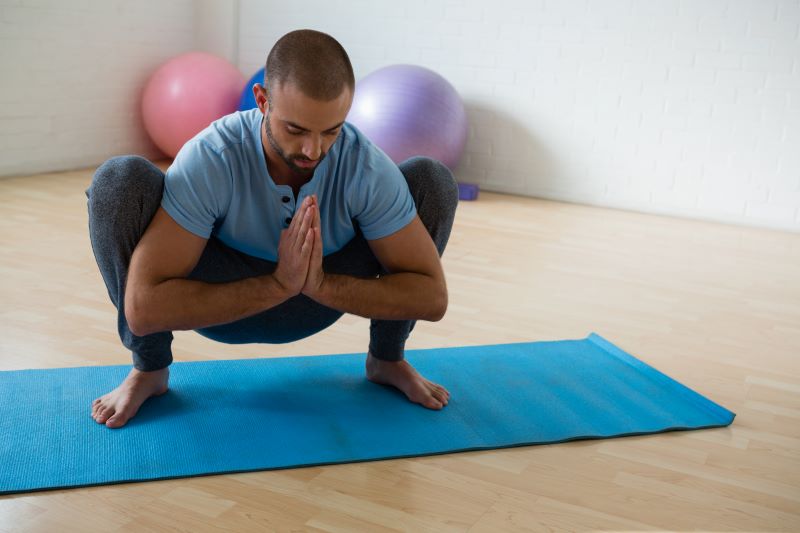
In the Anjali Mudra or Prayer Position, bring your palms together in front of your chest in a prayer position. Keep your elbows pressed against the inner knees while maintaining the squatting posture. Ensure your spine is straight and your shoulders are relaxed.
Benefits of Anjali Mudra: This mudra promotes balance and harmony, encouraging a sense of unity and grounding. It also helps in focusing the mind and enhancing mental clarity.
2. Chin Mudra
In Malasana, sit with heels together and knees apart. Rest your palms on your knees facing up.
Touch the tip of your thumb to your index finger on each hand, creating the Chin Mudra for concentration.
Benefits of Chin Mudra: Chin Mudra enhances concentration and mental calmness. It also helps in directing prana (life force energy) throughout the body, fostering inner peace.
Types of Malasana
Malasana has several variations that accommodate varying degrees of strength and flexibility, each with its advantages. These are a few popular varieties of Malasana, each with unique qualities and benefits.
1. Basic Malasana
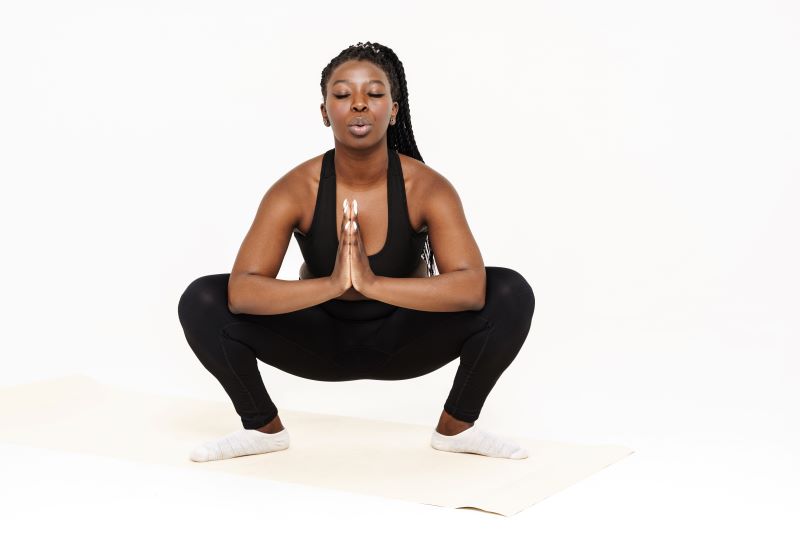
The basic form of Malasana is a straightforward squat with the heels on the floor and the feet close together. Anjali Mudra is made with the palms together in front of the chest and the elbows pressed against the inner knees. It strengthens the lower body, increases hip flexibility, and promotes better digestive health.
2. Parivrtta Malasana (Revolved Garland Pose)
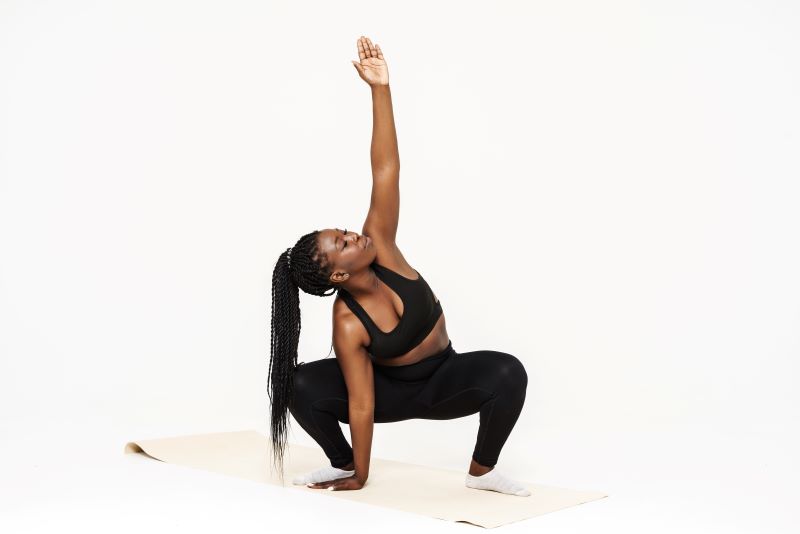
Parivrtta Malasana involves a twist from the basic squatting position. One arm is placed on the floor while the other arm reaches up towards the sky, creating a spinal twist that deepens the stretch. It improves spinal flexibility, enhances detoxification through the twist, and increases balance and coordination.
3. Sahaja Ardha Malasana (Spontaneous Flowing Half Squat)
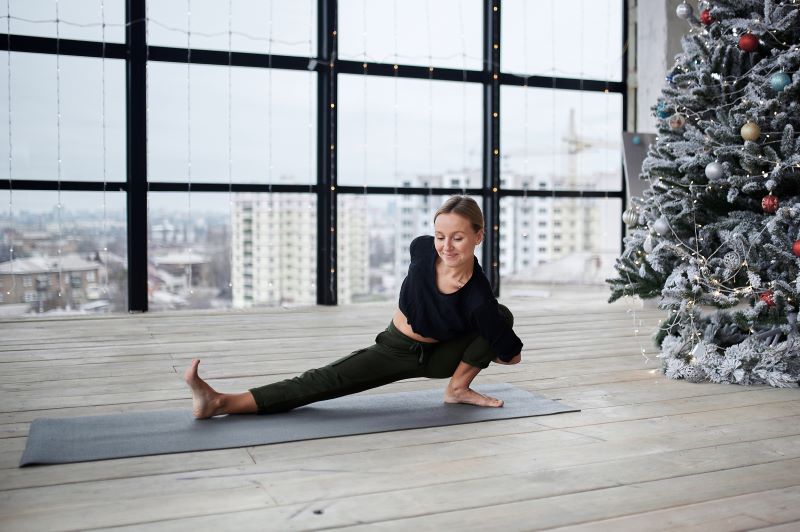
In Sahaja Ardha Malasana, one leg remains in the squatting position while the other leg is extended out to the side. The practitioner shifts weight fluidly from one side to the other. This dynamic pose increases flexibility in the hips and hamstrings, enhances balance, and promotes fluid movement and coordination.
Things to Know Before Doing Malasana Yoga
Malasana is a beneficial yoga posture that requires proper preparation and awareness to perform safely and effectively. Before integrating this pose into your routine, it's essential to consider several key points to maximise its benefits and avoid potential risks.
- Empty Stomach: Ensure you practice Malasana on an empty stomach. It is best performed in the morning or at least four hours after a meal to avoid discomfort and facilitate better movement.
- Warm-Up: Before attempting Malasana, perform a mild warm-up. This lowers the chance of injury by helping to loosen up the muscles and joints.
- Correct Alignment: Throughout the pose, maintain your alignment. To prevent strain, maintain a straight spine, align your knees with your toes, and equally distribute your weight across your feet.
- Gradual Progression: Begin by holding the pose for brief periods, then progressively extend that time. Your body can adjust as a result and develop the required flexibility and strength.
- Pay Attention to Your Body: Observe the cues your body is sending you. Release the pose gently if you feel pain or discomfort, and do not push yourself past your comfort zone.
- Seek Advice: Speak with a yoga instructor if you are new to the practice or if you have any underlying medical issues. Under expert instruction, you can guarantee that you execute Malasana safely and correctly.
How Long to Hold Malasana Position?
The duration for holding Malasana can vary based on your experience and comfort level. Here are recommendations for different practitioners:
- Beginners: Hold Malasana for 30 seconds to one minute. This duration allows your body to gradually build strength and flexibility without causing undue strain.
- Intermediate Practitioners: Sit in Malasana for 1 to 2 minutes. At this level, your body is more accustomed to the pose, allowing for a deeper stretch and improved benefits.
- Advanced Practitioners: Maintain the pose for up to 3 minutes or longer. Advanced practitioners can hold Malasana for extended periods to achieve maximum flexibility, strength, and mental focus.
Never forget that you should never push yourself past your comfort zone and that you should go at your own pace. If you experience any pain or strain, come out of the pose gently and take a break. During your yoga practice, always respect your body and its needs.
Risks of Overdoing Malasana
While Malasana offers numerous health benefits, overdoing this pose can lead to various risks and injuries. It's crucial to practice this posture with caution and mindfulness to avoid potential harm.
- Knee Strain: If proper alignment is not maintained, prolonged time spent in the Malasana pose may cause strain to the knee joints, resulting in pain or injury.
- Lower Back Pain: If the spine is not maintained straight, holding the pose for an extended period may result in lower back pain or injury.
- Hip Overuse: Extended periods in Malasana may overstress the hip joints and muscles, resulting in soreness or strain.
- Ankle and Foot Issues: Prolonged practice can lead to overuse injuries in the ankles and feet, including pain and inflammation, due to the sustained squat position.
- Circulation Issues: The pose may obstruct the lower body's blood flow for too long, resulting in tingling or numbness in the feet and legs.
Important Tips for Practising Malasana
A few essential tips that you need before you start practising Malasana are:
Do not move your hips up or down or bounce while doing this yoga. Incorrect hip posture can damage and overstrain your knees and hip flexors.
Lengthen the front side of your torso, and remember to keep your spine straight throughout.
Make slow and smooth movements, and remember not to jerk or pull any movement while doing this asana.
Throughout the yoga movement, keep shifting your weight to the heels.
What are the Precautions and Contraindications of Malasana?
Here are a few precautions and contraindications of the Malasana that you must be aware of:
Remember to practice this asana on an empty stomach. It is better to perform this in the morning on an empty stomach, or you can do it by keeping a gap of at least 4 hours after a meal.
While doing this yoga, do not put your entire weight on your heels or toes. This is not good for your feet. Instead, spread your body weight evenly throughout your feet.
Keep in mind to perform it for a limited time and do it gently. Do not overstrain yourself in a single session.
Get into the position of this yoga gently and slowly; avoid hurrying while performing this asana.
Do not perform Malasana if you have chronic knee or lower back pain, as it can be painful.
If you have knee or lower back pain or any other medical conditions related to your hips, legs, or spine, consult your doctor before doing this asana.
If you underwent any recent injury on your hips, knees, back, feet or ankle, it would be better if you do not practise this asana at all.
Do not practice this asana immediately after running. The tissues around your ankles, knees and calves are heated up after running, so putting pressure on them would not be wise.
Who Should Avoid Doing Malasana?
Garland Pose, also known as Malasana, might not be appropriate for everyone, particularly for those with certain medical conditions or physical restrictions. Being aware of these factors is critical to preventing pain and injury.
- People with Knee Injuries: People who suffer from persistent knee pain or injuries ought to stay away from the deep squatting pose known as Malasana because it can aggravate their knee problems and lead to additional harm.
- Those with Lower Back Issues: If you have a history of back problems, Attempting Malasana could put undue strain on your spine and exacerbate your lower back pain.
- Mid to Late Pregnant Women: The deep squat of Malasana can put excessive pressure on the abdomen and pelvis during pregnancy, especially in the later stages, which may result in discomfort or complications.
- People with Hip Conditions: Because Malasana requires a great deal of hip flexibility and can result in overuse injuries, practitioners with hip injuries or chronic hip pain should not practise this pose.
- Individuals with Ankle Problems: Because Malasana puts a lot of weight and pressure on the ankle joints, it might not be a good idea if you have weak or injured ankles.
Malasana can be good for a few individuals, but it is dangerous for people with severe injuries and problems. It is better to consult a doctor or a Yoga trainer before undergoing Malasana. Also, it is highly recommended for such individuals to have a health insurance plan to cover the cost of undergoing any treatment.
What are the Easy Modifications of Malasana?

The Malasana pose might be challenging for a few to master in one go. However, with regular practice, it will become easier to do. If you find it extremely challenging to perform this asana in one go, here are some ways you can modify the pose according to your comfort levels:
There will be chances where you see that your heels come up while doing this pose. So, keep a folded blanket under your feet for added support and balance.
You can also try placing a yoga block under each of your feet to make this yoga pose more comfortable and easy to do.
As a beginner, you can do this pose against the wall so that you get better support.
Remember that getting into the correct posture is essential for this pose. You can help yourself or a yoga master, your friend, or your family get into the correct posture.
To get more benefits from the Garland Pose, you can try placing one hand firmly on the floor, keeping it between your feet. Then, in the next step, raise your other hand upwards while you twist your torso.
So, now that you know the benefits of Malasana, you might want to add it to your yoga routine. However, only practising Malasana will not help you ease your bowel movements and have a good digestive system. Remember to keep a healthy lifestyle and eat healthy food to get an overall healthy body.














